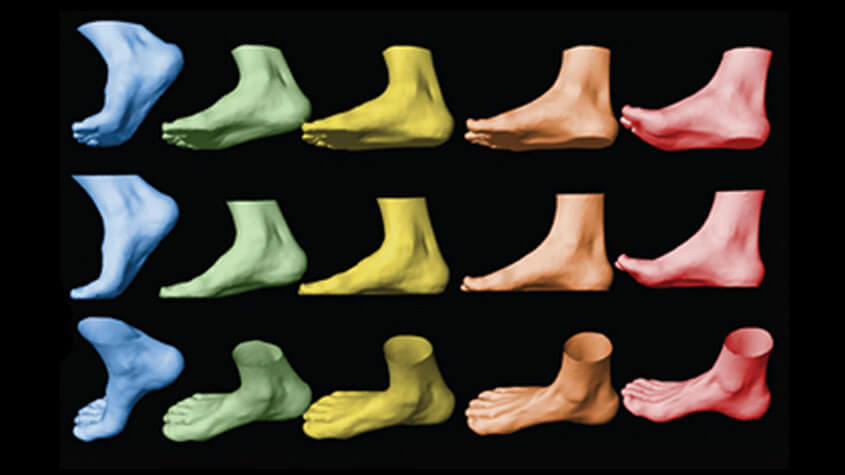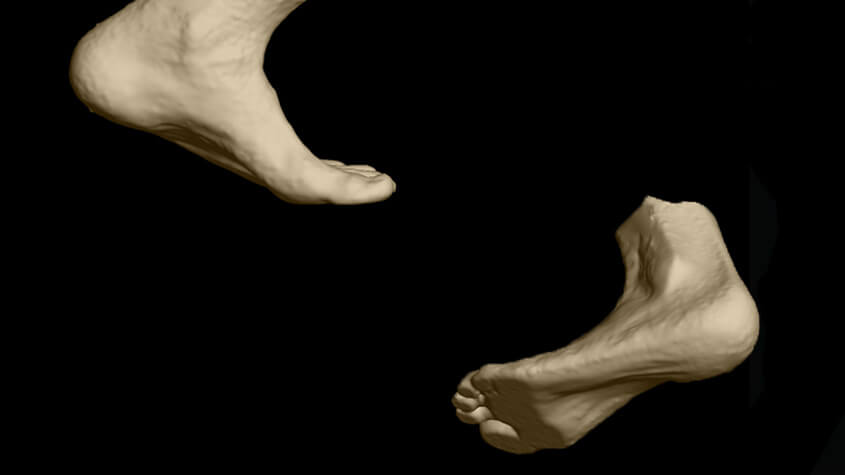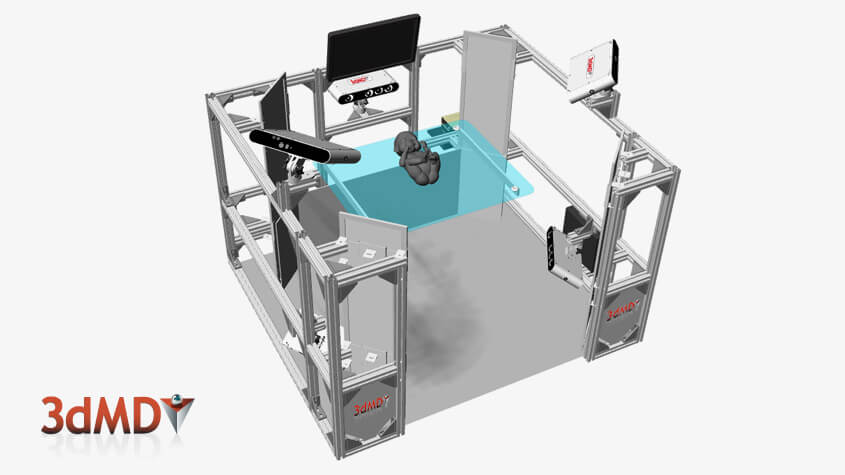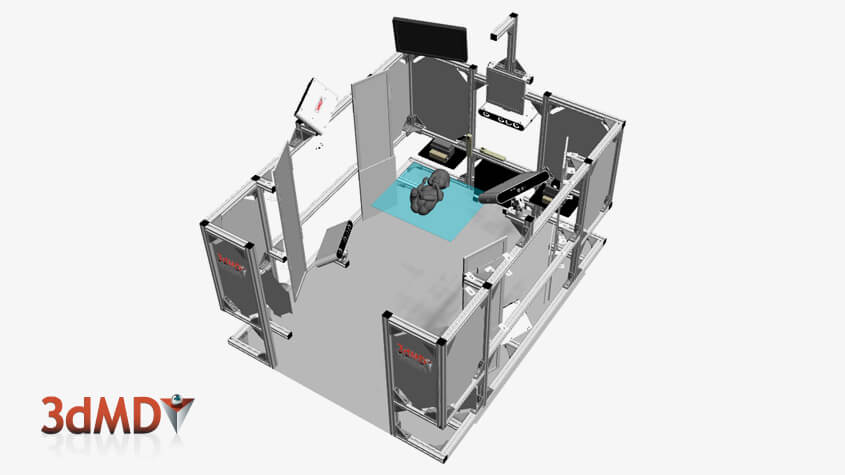3dMDface™ System / 3dMDtrio™ System
3dMDface™ System Product Specifications
| Region of Interest: | Provides 190-degree full face coverage [ear-to-ear]. Records a range of facial expressions, function, smile, and speech dynamically in 3D over a period of time (4D). |
| Capture Speed Options (3D frames per second): | 1-10fps, 1-30fps, or 1-60fps with high precision 3D shape information generated for each frame, regardless of capture speed. Run system in record, burst, or single snap mode. |
| 3D Image Reconstruction Technique: | Sophisticated software-driven triangulation technique called Active Stereo Photogrammetry. |
| 3D Image Reconstruction per Frame: | Automatic generation of an individual 3dMD image from all stereo viewpoints within the system to create a single continuous 3D point cloud or textured mesh (no manual stitching or registration needed per frame). |
| 3D Shape Accuracy: | Delivers ‘near-ground truth’, high-precision dense surface images with a linear accuracy range of 0.2mm or better... also known as first generation, Real-World data. |
| Output Options. | A progressive sequence of 3dMD images from a recording, a short progressive sequence of 3dMD images from a burst, and a single 3dMD image from a single snap. |
| Output. File Formats Supported: | obj, stl, ply, gltf, glb, x3d, 3mf, as well as all other industry-standard open formats for use in downstream 3dMD and third-party software. |
| System Configuration: | Incorporates optics-based technology with two (2) Modular Camera Units (MCUs) of six (6) machine vision cameras synchronized with a robust LED lighting system. |
| Camera Technology: | Industrial-grade Machine Vision camera technology. |
| Eye-Safe Lighting: | Safe and comfortable subject illumination within visible white light (100% LED lighting) which is helpful for prolonged sessions - no use of infrared (IR) or near Infrared (NIR) light waves. |
| Temporal Image Selection for Use Downstream: | Select the most optimal 3dMD images from the sequence [e.g. neutral, smile apex, mouth open, an infant in position after squirming all around, etc.]. |
| Environment: | Utilized in normal R&D lab, clinical, and studio environments. |
| Safety: | International UL and CE safety certification. |
| Upgrade Path to: | 3dMDtrio System (add 1 MCU) and a baseline 3dMDhead5 System (add 3 MCUs) or a specialized 3dMDhead System (add 5-7 MCUs) |
| Techniques and Technologies NOT Used by 3dMD: | To confirm, 3dMD does NOT use lasers, depth sensor cameras, pro/consumer cameras, or infrared (IR)/ near Infrared (NIR) light waves within its systems. 3dMD does NOT use a 'structured light' capture/reconstruction technique. |
| Technology Description Review Resource Prior to Publication: | If your team is describing 3dMD’s technology for publication, 3dMD is happy to review the section of the copy related to 3dMD and provide input, if needed, to ensure that the technology (only) is described correctly. Please contact review@3dMD.com. |
3dMDtrio™ System Product Specifications
| Region of Interest: | Provides 220-degree full face coverage [ear-to-ear-plus]. Captures a range of facial expressions, function, smile, and speech dynamically in 3D over a period of time (4D). |
| Capture Speed Options (3D frames per second): | 1-10fps, 1-30fps, or 1-60fps with high precision 3D shape information generated for each frame, regardless of capture speed. Run system in record, burst, or single snap mode. |
| 3D Image Reconstruction Technique: | Sophisticated software-driven triangulation technique called Active Stereo Photogrammetry. |
| 3D Image Reconstruction per Frame: | Automatic generation of an individual 3dMD image from all stereo viewpoints within the system to create a single continuous 3D point cloud or textured mesh (no manual stitching or registration needed per frame). |
| 3D Shape Accuracy: | Delivers ‘near-ground truth’, high-precision 3D dense surface images with a linear accuracy range of 0.2mm or better… also known as first generation, Real-World data. |
| Output Options: | A progressive sequence of 3dMD images from a recording, a short progressive sequence of 3dMD images from a burst, and a single 3dMD image from a single snap. |
| Output. File Formats Supported: | obj, stl, ply, gltf, glb, x3d, 3mf, as well as all other industry-standard open formats for use in downstream 3dMD and third-party software. |
| Camera Technology: | Industrial-grade Machine Vision camera technology. |
| Eye-Safe Lighting: | Safe and comfortable subject illumination within visible white light (100% LED lighting) which is necessary for prolonged sessions with subjects - no use of infrared (IR) or near Infrared (NIR) light waves. |
| 3dMD Image(s) Downstream: | Either 1) select the most optimal 3dMD images from the sequence [e.g. neutral, smile apex, mouth open, an infant in position after squirming all around, etc.] OR 2) import the entire 3dMD image sequence into the downstream 3dMDtempus software to transition a project from a static-3D to a dynamic-3D/4D dense-surface mobility paradigm. |
| Environment: | Utilized in normal R&D lab, clinical, and studio environments. |
| Safety: | International UL and CE safety certification. |
| Upgrade Path to: | A baseline 3dMDhead5 System (add 2 MCUs) or a specialized 3dMDhead System (add 4-9 MCUs). |
| Third-Party Device Synchronization: | For advanced customer teams who qualify, 3dMD offers a range of 3dMDsync Unit options – e.g. Synchronization Output only, Synchronization Output and Input, and Synchronization Output and Input with Frame Level timestamping functionality. |
| Techniques and Technologies NOT Used by 3dMD: | To confirm, 3dMD does NOT use lasers, depth sensor cameras, pro/consumer cameras, or infrared (IR)/near Infrared (NIR) light waves within its systems. 3dMD does NOT use a 'structured light' capture/reconstruction technique. |
| Technology Description Review Resource Prior to Publication: | If your team is describing 3dMD’s technology for publication, 3dMD is happy to review the section of the copy related to 3dMD and provide input, if needed, to ensure that the technology (only) is described correctly. Please contact review@3dMD.com. |
3dMDhead™ System Series
3dMDhead™ System Product Specifications
| Region of Interest: | Provides 360-degree full head and face coverage. Captures a range of head postures, as well as facial expressions, functions, smile, and speech dynamically in 3D over a period of time (4D). |
| Capture Speed Options (3D frames per second): | 1-10fps, 1-30fps, or 1-60fps with high precision 3D shape information generated for each frame, regardless of capture speed. Run system in record, burst, or single snap mode. |
| 3D Image Reconstruction Technique: | Sophisticated software-driven triangulation technique called Active Stereo Photogrammetry. |
| 3D Image Reconstruction per Frame: | Automatic generation of an individual 3dMD image from all stereo viewpoints within the system to create a single continuous 3D point cloud or textured mesh (no manual stitching or registration needed per frame). |
| 3D Shape Accuracy: | Depending on system configuration... delivers ‘near-ground truth’, high-precision 3D dense surface image with a linear accuracy range of 0.2mm or better… also known as first generation, Real-World data. |
| Output Options: | A progressive sequence of 3dMD images from a recording, a short progressive sequence of 3dMD images from a burst, and a single 3dMD image from a single snap. |
| Output. File Formats Supported: | obj, stl, ply, gltf, glb, x3d, 3mf, as well as all other industry-standard open formats for use in downstream 3dMD and third-party software. |
| Baseline 3dMDhead5 System Configuration: | 3dMDhead5 System. Incorporates optics-based technology with five (5) Modular Camera Units (MCUs) of 15 machine vision cameras synchronized with a robust LED lighting system. |
| Specialized 3dMDhead System Configurations: | Depending on area of interest requirements, 3dMD can configure the 3dMDhead5 System to include additional MCUs aimed to increase detail in the eye and ear regions. 3dMDhead system configurations range from the baseline of 5 MCUs|15 machine vision cameras to 12 MCUs|36 machine vision cameras. |
| Camera Technology: | Industrial-grade Machine Vision camera technology. |
| Eye-Safe Lighting: | Safe and comfortable subject illumination within visible white light (100% LED lighting) which is necessary for prolonged sessions with subjects - no use of infrared (IR) or near Infrared (NIR) light waves. |
| 3dMD Image(s) Downstream: | Either 1) select the most optimal 3dMD images from the sequence [e.g. neutral, smile apex, mouth open, an infant in position after squirming all around, etc.] OR 2) import the entire 3dMD image sequence into the downstream 3dMDtempus software to transition a project from a static-3D to a dynamic-3D/4D mobility paradigm. |
| Environment: | Utilized in normal R&D lab, clinical, and studio environments. |
| Safety: | International UL and CE safety certification. |
| Upgrade Path to: | Any specialized 3dMDhead System (add 2-7 MCUs). |
| Third-Party Device Synchronization: | For advanced customer teams who qualify, 3dMD offers a range of 3dMDsync Unit options – e.g. Synchronization Output only, Synchronization Output and Input, and Synchronization Output and Input with Frame Level timestamping functionality. |
| Techniques and Technologies NOT Used by 3dMD: | To confirm, 3dMD does NOT use lasers, depth sensor cameras, pro/consumer cameras, or infrared (IR)/near Infrared (NIR) light waves within its systems. 3dMD does NOT use a 'structured light' capture/reconstruction technique. |
| Technology Description Review Resource Prior to Publication: | If your team is describing 3dMD’s technology for publication, 3dMD is happy to review the section of the copy related to 3dMD and provide input, if needed, to ensure that the technology (only) is described correctly. Please contact review@3dMD.com. |
3dMDhand™ System Series
3dMDhand™ System Product Specifications
| Region of Interest: | Depending on system configuration... provides 360-degree full hand coverage for a single hand or both hands. Captures a range of hand articulations, gestures, actions, and interactions dynamically in 3D over a period of time (4D). |
| Capture Speed Options (3D frames per second): | 1-10fps, 1-30fps, or 1-60fps with high precision 3D shape information generated for each frame, regardless of capture speed. Run system in record, burst, or single snap mode. |
| 3D Image Reconstruction Technique: | Sophisticated software-driven triangulation technique called Active Stereo Photogrammetry. |
| 3D Image Reconstruction per Frame: | Automatic generation of an individual 3dMD image from all stereo viewpoints within the system to create a single continuous 3D point cloud or textured mesh (no manual stitching or registration needed per frame). |
| 3D Shape Accuracy: | Depending on system configuration... delivers 'near-ground truth', high-precision 3D dense surface images with a linear accuracy range of 0.7mm or better… also known as first generation, Real-World data. |
| Output Options: | A progressive sequence of 3dMD images from a recording, a short progressive sequence of 3dMD images from a burst, and a single 3dMD image from a single snap. |
| Output. File Formats Supported: | obj, stl, ply, gltf, glb, x3d, 3mf, as well as all other industry-standard open formats for use in downstream 3dMD and third-party software. |
| Baseline 3dMDhand System Configuration: | 3dMDhand7 System captures a single hand. Incorporates optics-based technology with seven (7) Modular Camera Units (MCUs) of 21 machine vision cameras synchronized with a robust LED lighting system. |
| Specialized 3dMDhand System Configurations: | Depending on requirements [single or two hands; interaction with each other or an inanimate object; etc.], 3dMD can configure the 3dMDhand System to include additional MCUs to accommodate these requirements. 3dMDhand system configurations range from the baseline of 7 MCUs|21 machine vision cameras to 16+ MCUs|48+ machine vision cameras. |
| Camera Technology: | Industrial-grade Machine Vision camera technology. |
| Eye-Safe Lighting: | Safe and comfortable subject illumination within visible white light (100% LED lighting) which is necessary for prolonged sessions with subjects - no use of infrared (IR) or near Infrared (NIR) light waves. |
| 3dMD Image(s) Downstream: | Either 1) select the most optimal 3dMD images from the sequence [e.g. an interaction, gesture, finger articulation, etc.] OR 2) import the entire 3dMD image sequence into the downstream third-party/in-house software to transition a project from 2D video (or sparse-3D) to a dynamic-3D/4D dense-surface mobility paradigm. |
| Environment: | Utilized in normal R&D lab, clinical, and studio environments. |
| Safety: | International UL and CE safety certification. |
| Upgrade Path to: | Any specialized 3dMDhand System (add 2-9+ MCUs). |
| Third-Party Device Synchronization: | For advanced customer teams who qualify, 3dMD offers a range of 3dMDsync Unit options – e.g. Synchronization Output only, Synchronization Output and Input, and Synchronization Output and Input with Frame Level timestamping functionality. |
| Techniques and Technologies NOT Used by 3dMD: | To confirm, 3dMD does NOT use lasers, depth sensor cameras, pro/consumer cameras, or infrared (IR)/near Infrared (NIR) light waves within its systems. 3dMD does NOT use a 'structured light' capture/reconstruction technique. |
| Technology Description Review Resource Prior to Publication: | If your team is describing 3dMD’s technology for publication, 3dMD is happy to review the section of the copy related to 3dMD and provide input, if needed, to ensure that the technology (only) is described correctly. Please contact review@3dMD.com. |
3dMDbody™ System Series
3dMDbody™ System Product Specifications
| Region of Interest: | Provides 360-degree full body coverage. Captures a range of postures, poses, actions, gestures, etc. dynamically in 3D over a period of time (4D). |
| Capture Speed Options (3D frames per second): | 1-10fps, 1-30fps, 1-60fps, or 1-120fps with high precision 3D shape information generated for each frame, regardless of capture speed. Run system in record, burst, or single snap mode. |
| 3D Image Reconstruction Technique: | Sophisticated software-driven triangulation technique called Active Stereo Photogrammetry. |
| 3D Image Reconstruction per Frame: | Automatic generation of an individual 3dMD image from all stereo viewpoints within the system to create a single continuous 3D point cloud or textured mesh (no manual stitching or registration needed per frame). |
| 3D Shape Accuracy: | Delivers 'near ground truth', high-precision 3D dense surface images with a linear accuracy range of 0.7mm or better… also known as first generation, Real-World data. |
| Output Options: | A progressive sequence of 3dMD images from a recording, a short progressive sequence of 3dMD images from a burst, and a single 3dMD image from a single snap. |
| Output. File Formats Supported: | obj, stl, ply, gltf, glb, x3d, 3mf, as well as all other industry-standard open formats for use in downstream 3dMD and third-party software. |
| Baseline 3dMDbody System Configuration: | 3dMDbody10 System captures a standard A-pose and similar poses for average-sized people. Incorporates optics-based technology with ten (10) Modular Camera Units (MCUs) of 30 machine vision cameras synchronized with a robust LED lighting system. |
| Specialized 3dMDbody System Configurations: | Depending on requirements [types of poses, actions, gestures, interactions; areas of interest; etc.], 3dMD can configure the 3dMDbody System to include additional MCUs to accommodate these requirements. 3dMDbody system configurations range from the baseline of 10 MCUs|30 machine vision cameras to 30+ MCUs|90+ machine vision cameras. |
| Camera Technology: | Industrial-grade Machine Vision camera technology. |
| Eye-Safe Lighting: | Safe and comfortable subject illumination within visible white light (100% LED lighting) which is necessary for prolonged sessions with subjects - no use of infrared (IR) or near Infrared (NIR) light waves. |
| 3dMD Image(s) Downstream: | Either 1) select the most optimal 3dMD images from the sequence [e.g. an interaction, gesture, finger articulation, etc.] OR 2) import the entire 3dMD image sequence into the downstream 3dMD, third-party, or in-house software to transition a project from 2D video, sparse-3D, or static-3D to a dynamic-3D/4D dense-surface mobility paradigm. |
| Environment: | Utilized in normal R&D lab, clinical, and studio environments. |
| Safety: | International UL and CE safety certification. |
| Upgrade Path to: | Any specialized 3dMDbody System (add 2-20+ MCUs). |
| Third-Party Device Synchronization: | For advanced customer teams who qualify, 3dMD offers a range of 3dMDsync Unit options – e.g. Synchronization Output only, Synchronization Output and Input, and Synchronization Output and Input with Frame Level timestamping functionality. |
| Techniques and Technologies NOT Used by 3dMD: | To confirm, 3dMD does NOT use lasers, depth sensor cameras, pro/consumer cameras, or infrared (IR)/near Infrared (NIR) light waves within its systems. 3dMD does NOT use a 'structured light' capture/reconstruction technique. |
| Technology Description Review Resource Prior to Publication: | If your team is describing 3dMD’s technology for publication, 3dMD is happy to review the section of the copy related to 3dMD and provide input, if needed, to ensure that the technology (only) is described correctly. Please contact review@3dMD.com. |
3dMDfoot™ System Series
3dMDfoot™ System Product Specifications
| Region of Interest: | Provides 360-degree full foot coverage [including the bottom] of one or two feet. Captures natural step with foot articulation dynamically in 3D over a period of time (4D). |
| Capture Speed Options (3D frames per second): | 1-40fps, 1-60fps, or 1-120fps with high precision 3D shape information generated for each frame, regardless of capture speed. Run system in record, burst, or single snap mode. |
| 3D Image Reconstruction Technique: | Sophisticated software-driven triangulation technique called Active Stereo Photogrammetry. |
| 3D Image Reconstruction per Frame: | Automatic generation of an individual 3dMD image from all stereo viewpoints within the system to create a single continuous 3D point cloud or mesh (no manual stitching or registration needed per frame). |
| 3D Shape Accuracy: | Delivers ‘near-ground truth’, high-precision 3D dense surface images with a linear accuracy range of 0.7mm or better… also known as first generation, Real-World data. |
| Output Options: | A progressive sequence of 3dMD images from a recording, a short progressive sequence of 3dMD images from a burst, and a single 3dMD image from a single snap. |
| Output. File Formats Supported: | obj, stl, ply, gltf, glb, x3d, 3mf, as well as all other industry-standard open formats for use in downstream 3dMD and third-party software. |
| Baseline 3dMDfoot System Configuration: | 3dMDfoot5 System captures a single foot. Incorporates optics-based technology with five (5) viewpoints synchronized with a robust LED lighting system. |
| Specialized 3dMDfoot System Configurations: | Depending on requirements [one or two feet; types of actions; areas of interest; etc.], 3dMD can configure the 3dMDfoot System to include additional MCUs to accommodate these requirements. 3dMDfoot system configurations range from the baseline of 5 viewpoints to 15+ viewpoints. |
| Camera Technology: | Industrial-grade Machine Vision camera technology. |
| Eye-Safe Lighting: | Safe and comfortable subject illumination within visible white light (100% LED lighting) which is necessary for prolonged sessions with subjects - no use of infrared (IR) or near Infrared (NIR) light waves. |
| 3dMD Image(s) Downstream: | Either 1) select the most optimal 3dMD images from the sequence [e.g. foot articulation, heel-strike, fully weighted, etc.] OR 2) import the entire 3dMD image sequence into the downstream third-party/in-house software to transition a project from 2D video, sparse-3D, or static-3D to a dynamic-3D/4D dense-surface mobility paradigm. |
| Environment: | Utilized in normal R&D lab, clinical, and studio environments. |
| Safety: | International UL and CE safety certification. |
| Upgrade Path to: | Any specialized 3dMDfoot System (add 5-10+ viewpoints). |
| Third-Party Device Synchronization: | For advanced customer teams who qualify, 3dMD offers a range of 3dMDsync Unit options – e.g. Synchronization Output only, Synchronization Output and Input, and Synchronization Output and Input with Frame Level timestamping functionality. |
| Techniques and Technologies NOT Used by 3dMD: | To confirm, 3dMD does NOT use lasers, depth sensor cameras, pro/consumer cameras, or infrared (IR)/near Infrared (NIR) light waves within its systems. 3dMD does NOT use a 'structured light' capture/reconstruction technique. |
| Technology Description Review Resource Prior to Publication: | If your team is describing 3dMD’s technology for publication, 3dMD is happy to review the section of the copy related to 3dMD and provide input, if needed, to ensure that the technology (only) is described correctly. Please contact review@3dMD.com. |
3dMDflex™ System Series
3dMDflex™ System Product Specifications
| Region of Interest: | 3dMD can configure a 3dMDflex System to meet specialized requirements. Captures a range of images dynamically in 3D over a period of time (4D). |
| Capture Speed Options (3D frames per second): | 1-10fps, 1-30fps, or 1-60fps with high precision 3D shape information generated for each frame, regardless of capture speed. Run system in record, burst, or single snap mode. |
| 3D Image Reconstruction Technique: | Sophisticated software-driven triangulation technique called Active Stereo Photogrammetry. |
| 3D Image Reconstruction per Frame: | Automatic generation of an individual 3dMD image from all stereo viewpoints within the system to create a single continuous 3D point cloud or textured mesh (no manual stitching or registration needed per frame). |
| 3D Shape Accuracy: | Depending on configuration... delivers ‘near-ground truth’, high-precision 3D dense surface images with a linear accuracy range of 0.7mm or better… also known as first generation, Real-World data. |
| Output Options: | A progressive sequence of 3dMD images from a recording, a short progressive sequence of 3dMD images from a burst, and a single 3dMD image from a single snap. |
| Output. File Formats Supported: | obj, stl, ply, gltf, glb, x3d, 3mf, as well as all other industry-standard open formats for use in downstream 3dMD and third-party software. |
| Camera Technology: | Industrial-grade Machine Vision camera technology. |
| Eye-Safe Lighting: | Safe and comfortable subject illumination within visible white light (100% LED lighting) which is necessary for prolonged sessions with subjects - no use of infrared (IR) or near Infrared (NIR) light waves. |
| 3dMD Image(s) Downstream: | Either 1) select the most optimal 3dMD images from the sequence OR 2) import the entire 3dMD image sequence into the downstream third-party/in-house software to transition a project from 2D video, sparse-3D, or static-3D to a dynamic-3D/4D dense-surface mobility paradigm. |
| Environment: | Utilized in normal R&D lab, clinical, and studio environments. |
| Safety: | International UL and CE safety certification. |
| Upgrade Path to: | A more specialized 3dMD System to increase surface coverage of the region of interest. |
| Third-Party Device Synchronization: | For advanced customer teams who qualify, 3dMD offers a range of 3dMDsync Unit options – e.g. Synchronization Output only, Synchronization Output and Input, and Synchronization Output and Input with Frame Level timestamping functionality. |
| Techniques and Technologies NOT Used by 3dMD: | To confirm, 3dMD does NOT use lasers, depth sensor cameras, pro/consumer cameras, or infrared (IR)/near Infrared (NIR) light waves within its systems. 3dMD does NOT use a 'structured light' capture/reconstruction technique. |
| Technology Description Review Resource Prior to Publication: | If your team is describing 3dMD’s technology for publication, 3dMD is happy to review the section of the copy related to 3dMD and provide input, if needed, to ensure that the technology (only) is described correctly. Please contact review@3dMD.com. |







